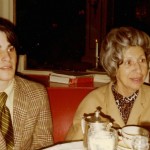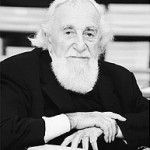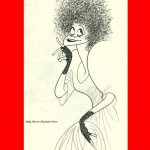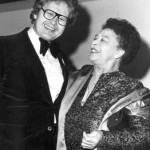by Michael Elihu Colby
Part 16: Coming Attractions
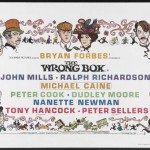



Among the first show folk for whom we auditioned were Teddy and Dorothy Hart. This took place during the summer of 1971 in a room with a piano at the Beverly Hills Hotel. Among my top fantasies fulfilled at that hotel was when the Harts responded enthusiastically. Teddy—brother of my idol, lyricist Larry Hart—was a veteran actor I’d admired in films like Three Men On a Horse and Mickey One (as Warren Beatty’s eccentric manager, a role touted for Academy Award consideration). Dorothy became a champion of my lyrics and—a few years later—engaged me as researcher for her biography of Larry Hart. Sadly, Teddy Hart passed away several months later (not long after my father died), but the affinity between families was fortified that evening.
Meanwhile, the auditions continued. Grandma, who’d often warned Douglas and me about the heartbreak of show business, did an about-face and morphed, essentially, into our unpaid agent. She somehow arranged for us to present our songs—sometimes performed by us, sometimes by real singers—for the likes of Shirley Bernstein, sister of Leonard Bernstein as well as manager of Stephen Schwartz (Godspell, Pippin, Wicked). That audition went okay—Shirley Bernstein even said she’d review our demo and script afterwards. I thought it was a promising sign when she phoned me back within days. “Is this Mr. Colby?” she said respectfully. “Yes, yes!” I answered. She added, with what sounded like receptivity, “Well, I must tell you, I cahn’t find enough enthusiasm to represent your work.” I was thrilled, interpreting what she said as boundless enthusiasm, and replied à la Sally Field, “Oh, Ms. Bernstein. So you really, really like it!” She rejoined, “Mr. Colby, you don’t quite understand. I cahn’t find enough enthusiasm! I cahn’t!”
In addition, Grandma arranged for us to see a Broadway composer who was one of the smallest in height but one of the giants in talent: Jule Styne, composer of Gypsy, Funny Girl, Bells Are Ringing, and countless standards (“Three Coins In a Fountain,” “Let It Snow,” “Diamonds Are a Girl’s Best Friend,” et al.) Styne was likewise a Broadway producer, responsible for the smash revival of Pal Joey with its score by Richard Rodgers & Larry Hart; he’d even once proposed a D’Oyly Carte style repertory of Rodgers & Hart shows.
Regardless of how things turned out, Douglas and I felt honored to just be visiting his office, above the Mark Hellinger Theatre. Filling the walls and shelves were awards, posters, and pictures of this musical genius who’d been instrumental in the careers of Carol Channing, Ethel Merman, Judy Holliday, Barbra Streisand, Frank Sinatra, and so many others. I remember Styne—who himself had composed a wonderful musical set in Victorian times (Darling of the Day)—went out of his way to be supportive to two hopeful teenagers; he leveled only minor criticism about anachronistic words. He was someone who could even make criticism seem like the highest of compliments.
I can’t claim the same for every individual for whom we auditioned, like the producer who said our show “hadn’t a Chinaman’s chance” or the one who reacted to songs like he was smelling a loaded diaper. Then there was the morning we auditioned for another theatre idol, producer/director Harold Prince. Oscar Hammerstein II’s words popped into my head because we were all “as jumpy as a puppet on a string.” 1 The performance, too, was shaky, and Harold Prince—whose shows like Cabaret and Company had been my touchstones—was blunt. He singled out my lyrics, saying I “needed to do more homework.” For a week after that, I felt as low as a centipede’s toe. But he was right—my writing skills needed considerable more honing. And, years later, I felt redeemed when Prince wrote me an enthusiastic letter about Charlotte Sweet.
As much as I appreciated these opportunities, my insecurities worsened—I knew we were mainly being seen because of who my grandparents were. I’d reassure myself that family connections have helped open doors for many worthies. But, the fear would always be there that I couldn’t make good on my own. And my father’s experience haunted me. As he found—when he went to work at another hotel—it could be overwhelming for family members trying to live up to the stature of my grandparents and the Algonquin. And yet it was because of the heady fruits we’d tasted that the hunger would persist. And so did the auditions.
Perhaps the best audition Douglas and I gave was for producer Stuart Ostrow, whose 1776 remains one of my favorite musicals. I,myself, sang opposite a pretty student from Finch College, whom Leslie Sank, my friend who attended Finch, recommended. The singer’s name was Sasha Purl; but years later she became better known as TV actress and cabaret singer Linda Purl. She was charm personified and could have performed a musical version of Jaws and made it delightful. Accordingly, even though Ostrow passed on the show, he was very encouraging. And, a few years later, I would be working for him.
Leslie Sank recommended an equally impressive leading lady—from Finch College—to sing with me at another audition. Her name was Nina Hirschfeld. I only vaguely remember the audition itself (It was for my grandparents’ friends in their 10th floor living room). But I’ll never forget rehearsing at Nina’s home, a townhouse on the upper East Side. You see, Nina hailed from an illustrious show business family. Her mother was Dolly Haas, a German actress who’d been in Hitchcock’s film I Confess and who’d succeeded Mary Martin in the Broadway musical Lute Song (Nina strongly resembled her mother with red hair and features reminiscent of a Renoir painting). Her father was the definitive caricaturist of Broadway, Al Hirschfeld. Inspired by him as a teenager, I’d created musical theatre caricatures that were framed in my bedroom. I followed his work religiously and, on several occasions, I’d seen him from afar at the Algonquin. He was an extremely distinguished looking gentleman with a long white beard; he resembled a cross between Prospero in The Tempest and my image of what God must look like.
Nina herself was well known because her father customarily concealed her name (usually several times) in each of his drawings. The one exception was a caricature of Nina (titled “Nina’s Revenge”) which he drew around the time she appeared in a City Center revival of Where’s Charley?; in this portrait he hid the name of her mother, “Dolly”.
For a theatre fan, entering the Hirschfeld townhouse was like awaking in Wonderland. His caricatures, both life-size and in miniatures, were everywhere. Each tile around the fireplace featured a cameo appearance: Ethel Merman, Mary Martin, Carol Channing, the Marx Brothers. The wallpaper against the ascending staircase portrayed celebrities—as if they were partying right in front of you—Tallulah Bankhead, Charlie Chaplin, Marlene Dietrich, Albert Einstein, George Bernard Shaw, Pablo Picasso, Benny Goodman, Eleanor Roosevelt, Ed Sullivan, Monroe, Sinatra. It was breathtaking.
As I left the townhouse, I had no idea of the circumstances under which I’d return there a decade later.
My second visit was in 1983, right when the Charlotte Sweet cast recording was being assembled. Al Hirschfeld had already done one caricature of the show—a profile of actress Polly Pen—after attending the same performance as critic Edith Oliver of The New Yorker, who wrote one of the show’s most negative reviews. Like an object lesson in how differently two people can react to the same performance, it turned out Hirschfeld had loved the show and was recommending it to his friends. Using Nina’s home number, I dialed to see if he’d be interested in doing a caricature of the full cast for the album. His wife, Dolly, answered the phone. I announced, “Hello, this is Michael Colby. I used to audition with your daughter Nina.” She replied, “Ya.” I added, “And you know my grandparents—the Bodnes of the Algonquin.” She replied, “Ya.” I added, “And I wrote Charlotte Sweet.” She responded, “You wrote Charlotte Sweet! You wrote Charlotte Sweet! Al, get on the phone!” The next week, I visited the Hirschfeld townhouse and picked up his illustration of the entire cast—which he joyfully handed over to me. It was one of the greatest thrills of my life, having my characters come to life on his easel and witnessing admiration from a nonpareil as Hirschfeld.
There was another theatre figure who gave me tremendous early encouragement. His name was Ben Bagley, and he was quite a personality. A gaunt, chain-smoking rascal—devoted to his cats (at various times, Butch, Fogarty, and Emily)2—he had a slightly vampiric look as if he’d stepped out of an Edward Gorey sketch. He was esteemed for producing hit off-Broadway revues and invaluable recordings of lesser-known gems by Broadway’s master songwriters, from Rodgers & Hart to Leonard Bernstein. Through three small original revues he produced, he helped launch the careers of such Broadway mainstays as Charles Strouse, Lee Adams, & Michael Stewart (who together wrote Bye Bye Birdie), Tom Jones & Harvey Schmidt (The Fantasticks), Sheldon Harnick, and future stars, Beatrice Arthur, Joel Grey, Tammy Grimes, Charlotte Rae, and Chita Rivera. Long before Ain’t Misbehavin’, he likewise popularized retrospective revues with the show Decline and Fall of the Entire World as Seen Through the Eyes of Cole Porter. 3
I met Ben Bagley through Dorothy Hart, when he joined her for dinner at the Algonquin. Always in need of money and generally hungry, he relished visiting the Algonquin’s restaurants. Dorothy suggested I give him a demo recording of Where There’s a Will. He immediately responded to the Colby brothers songs, not just to return for meals, but because of Douglas’s lovely melodies and my macabre humor (One song he particularly liked was “The Cemetery Social Set,” about a group of Victorian society figures who hobnobbed from funeral to funeral: “All the upper crust of England can be found h’ya,/ Whether tête-à-tête or strictly in the ground h’ya.” 4).
His own recordings featured the cream of the crop: from consummate entertainers like Dorothy Loudon, Barbara Cook and Bobby Short, to stars who didn’t usually sing (sometimes with good reason) like Katharine Hepburn, Joanne Woodward and Joan Rivers. His liner notes were notoriously irreverent. To quote one of his more subdued notes, describing a song from the Fred Astaire film Royal Wedding (on “Ben Bagley’s Alan Jay Lerner Revisited”):
The movie is chiefly memorable in that it introduced Winston Churchill’s elfin daughter, Sarah, to millions of moviegoers. Perfectly cast in a musical, Miss Churchill sang almost as well as Margaret Truman, and danced even better.5
Other typical notes were from “Ben Bagley’s Ira Gershwin Revisited:”
This is the second recording [of this] song. The first was by that sweet little Irish colleen Ella Fitzgerald. …
While hospitalized recently for hepatitis, I worked on a list of all the people I’d had carnal knowledge of during the past year in an attempt to trace the person who infected me. It added up to 78 men and women, none of whose names, except two, could I recall. If anyone reading this knows the whereabouts of Joan and Larry Rivers, tell them to get globulin shots.” To requote that oft-quoted line of Erich Segal’s, “Sex is not a sin if you’re sorry.”
Though he rubbed many people the wrong way, he couldn’t have been nicer to me. I proved helpful to him too. As researcher for Dorothy Hart, I tracked down some lost Rodgers & Hart songs, which he included on two of his albums. But what most endeared him to me was that anytime I was in the doldrums (especially after my work had been rejected), he somehow knew to phone me. He might even curse out the naysayer. Though it’s not my manner to use profanity, it could be cathartic hearing Ben using his typical expression to describe anyone who was unnecessarily unkind: “that c***s*****!” (And the “c.s.” didn’t stand for Charlotte Sweet).
Another supporter of my work was right in my family, Aunt Cyd Mazo. For a while, Aunt Cyd lived at the Colby home in Hewlett—to help out when my father left for Washington D.C. When she was younger, Aunt Cyd was considered the great beauty among my grandmother’s attractive sisters. With high cheekbones, big chestnut eyes, and a model’s figure, she looked a bit like Maureen O’Hara. Back in Charleston, George Gershwin had been captivated by her: an exquisite, innocent Jewish girl who was attracted to him for himself not his fame. She regretted that she hadn’t pursued him to New York and was distraught when he died. Since then, Aunt Cyd’s life had been tough: she’d been divorced twice from the same difficult husband and had suffered a miscarriage during the marriage. Though she was exceptionally loving to all her nephews and nieces, Douglas and I became like surrogate sons to her (We were the two relatives at her hospital bedside when she—a heavy smoker—passed away of emphysema).
During the period Aunt Cyd was at our house, she alleviated the screaming with jokes and laughter—whether pulling off one of her wigs or making cracks about our neighbors. She became one of the stars—along with my brothers—of the creative home movies I made (Comic skits in the style of Laugh-In and The Ernie Kovacs Show). Grandma Mary sent her to chaperone Douglas and me on another trip to the Beverly Hills Hotel. During that trip, she was present at the audition for Dorothy and Teddy Hart, cheering on her nephews. It was also during that trip she crashed the wedding—in the hotel’s Polo Lounge—of Sammy Cahn (lyricist of songs including “Three Coins in a Fountain,” “Let It Snow,” and “Come Fly With Me”). Claiming to be “Peter O’Toole’s girlfriend, Sue Mazo,” she infiltrated the wedding reception as Douglas and I watched through a glass partition. We saw Aunt Cyd dancing along as the band—commemorating Cahn’s second marriage—played the Cahn-Jimmy Van Heusen standard “[Love is lovelier] The Second Time Around.”
Aunt Cyd attended all my musicals that she could. She’d assert, “One day, when people know your name and sing your songs, please mention that I predicted it.” I can’t say Aunt Cyd’s prediction was fully achieved, but I can acknowledge how much I appreciated and loved her.
Alas, no one ever produced Where There’s a Will. Where there’s a WON’T was the response to the idea of giving a million-dollar production to two youngsters who didn’t even have rights permission. But I learned a lot from the experience. Foremost, I still needed to evolve as a writer. Secondly, the experience made me more likely to create completely original, smaller scale musicals from then on—where I didn’t have to worry about licensing rights or size. In time, I was able to get a Victorian musical produced, though even my brainchild, the relatively modest Charlotte Sweet, did not run as long as we’d hoped (We closed right after a general slump in N.Y. theatre grosses our financial reserve could not overcome).
The auditions for Where There’s a Will weren’t the only coming attractions of future shows in my family during this period. Our uncle Andrew Anspach was pursuing ideas for a cabaret series at the Algonquin—though plans wouldn’t be official until 1980. It was Uncle Andrew’s goal to restore the hotel’s policy of supper-club shows, dormant since around 1939—when Austrian singer Greta Keller briefly headlined there. Grandpa Ben resisted this idea, thinking the supper club hadn’t really caught on in the past so why take the risk. Nevertheless, Uncle Andrew and his friend, publicist Donald Smith, explored ways to make this dream happen.
From childhood, Uncle Andrew held an ardent interest in the arts, admitting, “Although I lacked the talent to make a life in the arts, I have [shaped] a very happy life with the arts.” As a pre-teen, he spent summers tap-dancing in top hat and tails at local theatres in Augusta, N.J. and nearby communities. He learned piano, clarinet, and tenor saxophone well enough to play in assorted orchestras, and earned his first money at age seventeen ($25!) playing in the jazz band at a graduation ball. After graduating, cum laude, from Newark Academy, he attended Yale, soon participating in both the Glee Club and the Dramat (their drama program). He earned the distinction of becoming the only Glee Club Manager in the history of Yale with a voice so off-key that he couldn’t sing with the group he managed. His thespian aspirations were also dashed at Yale’s Dramat, where he was deftly shunted from light acting on-stage to heavy performance on the Business Board.
It was years later, when he crossed paths with Donald Smith that his aspirations would truly flourish. Their original plan was to make the Algonquin the permanent home of the cabaret legend Mabel Mercer, for whom the devoted Smith worked many years as an unpaid promoter.7 It was my good fortune that Uncle Andrew would sometimes bring me along when he and Smith scouted cabaret personalities around town or attended Mabel Mercer’s shows at the St. Regis Hotel. The majestic Mabel Mercer was mesmerizing, less a full-out vocalist than a talk-singing interpreter mining the sorcery of a song lyric (typically by Hart, Porter, Hammerstein, Coward and Harburg)—the kind of performer a lyricist would adore. I was watching the embodiment of cabaret history while the future of cabaret was being formulated. I remember how, one night after seeing Mabel Mercer, Donald Smith invited Uncle Andrew and me to visit his East Side apartment decorated with pictures and other souvenirs of his inspirations such as Fred Astaire, Ethel Merman, Porter, and Coward. Smith was a large man with a Cheshire Cat face capped by wavy whitening hair; his conversation colored by his strong Massachusetts accent and declaratives like “Did you see that knock-‘em-dead gown Julie Wilson waw!” and “That man should be tahed and feathahed faw what he did to that song!”
That evening he and Uncle Andrew discussed how it was their duty to resurrect the elegance and high standards of past eras (as exemplified by Mabel Mercer, of course). Those words proved prophetic not only at the inception of the new Algonquin cabaret series, but in how Smith himself would one day found the Mabel Mercer Foundation (dedicated to the perpetuation of the art of cabaret) and the New York Cabaret Convention.
Fortune smiled again and again as Uncle Andrew took Douglas and me to hear nightclub singers. Among father figures, Grandpa Ben was more interested in taking us to ballgames, the Great American Pastime. But, like my father Sidney, Uncle Andrew saw the Colby boys were more interested in the Great American Songbook. Thanks to Uncle Andrew, we experienced the best of the best in cabaret, veteran and newbie, venue to venue: Bobby Short (Café Carlyle), George Shearing (the Stanhope), Alberta Hunter (the Cookery), Steve Ross (Backstage)—who, in place of Mabel Mercer, was the triumphant opening attraction when the Algonquin’s cabaret was re-launched in the Oak Room.
We even saw the venerable Bricktop: a once world-famous singer whose protégée had been Mabel Mercer at the popular Paris nightspot, Chez Bricktop. Bricktop’s real name was Ada Beatrice Queen Victoria Louise Virginia Smith—a little long for a marquee. 8 Born to a poor African-American family in Virginia, she sang her way into high society, moving to Paris, where Gertrude Stein, Ernest Hemingway, and the F. Scott Fitzgeralds frequented her nightspot.9 Cole Porter had written the song “Miss Otis Regrets” for her. Seeing her live, one felt in awe of what she’d accomplished and whom she’d known. There was also some sadness about the evanescence of her fame. So, I wouldn’t dare correct her after she introduced a song with complete misinformation. The song was “Where Or When” written by Rodgers & Hart for Babes in Arms. “And now,” she announced, “I am going to sing ‘Where Or When,’ a song Noel Coward wrote just for me.” What made the announcement extra ironic was the underlying lyric: “It seems we’ve stood and talked like this before…But who knows where or when.” 11
Perhaps Bricktop’s statement was, in itself, a coming attraction of how reality and imagination can blur in time; how what’s transformative can be transitory as well. But, pursuing theatre, I would learn it’s essential to hold onto your illusions when the actuality is less consoling. As actress Ruth Gordon, an Algonquin regular, used to proclaim, “The only way to have a life in the Arts is never face the facts.”
Thus, after all the effort and auditions, someone in the arts can finally get a break and fantastic memories (As occurred for me with Charlotte Sweet despite its short run). And sometimes dreams do come true—as with the resurrection of the Algonquin cabaret—even if success is relative (The cabaret recently closed after 32 years). The bottom line is that even if the moment of achievement doesn’t last, as it occurs, it is to be cherished.
Next part: You Mean, That Arnold Schwarzenegger?
1Hammerstein, Oscar II. Lyric to “It Might As Well Be Spring” from the musical movie State Fair (music: Richard Rodgers), produced by 20th Century Fox © 1945.
2 “Ben Bagley Biography” c/o Painted Smiles Records: https://www.facebook.com/pages/Painted-Smiles-Records/7100242179?sk=info. 2008.
3 Holden, Stephen, Ben Bagley obituary in The New York Times. New York, NY: March 27, 1998.
4 Colby, Michael. Lyric to “The Cemetery Social Set” from the musical Where There’s a Will (music: Douglas Colby) © 1971.
5 Bagley, Ben. Notes on “Ben Bagley’s Alan Jay Lerner Revisited.” Jackson Heights NY: Painted Smiles Records. 1992.
6 Bagley, Ben. Notes on “Ben Bagley’s Ira Gershwin Revisited.” Jackson Heights NY: Painted Smiles Records. 1992.
7 Holden, Stephen. “Donald F. Smith, Champion of Cabaret, Dies at 79”, obituary in The New York Times. New York. NY: March 13, 2012.
8 Monahan, Patrick. “To Bricktop, on Her Belated Birthday” from “Arts & Culture” section of The Daily” c/o the Paris Review. New York, NY: August 15, 2011.
9 From “Celebrity Beat—New York to Hollywood” in Jet Magazine, A Johnson Publication. Chicago, IL: September 26, 1983.
10 Leichner, Helen. ”Smith, Ada ‘Bricktop’ (1894-1984)” in BlackPast.org™ Blog: Remembered & Reclaimed: http://www.blackpast.org/aah/smith-ada-bricktop-1894-1984.© 2007
11Hart, Lorenz. Lyric to “Where Or When” from the musical Babes In Arms (music: Richard Rodgers) © 1937.
© 2014, Michael Colby
*No copyright Infringement Intended. For Entertainment Purposes Only.
Click Below for Parts 1 thru 15 :
https://www.theaterpizzazz.com/algonquin-kid-part-way-back/
https://www.theaterpizzazz.com/algonquin-kid-part-2-algonquin-renaissance/
https://www.theaterpizzazz.com/algonquin-kid-part-3-series/
https://www.theaterpizzazz.com/algonquin-kid-part-4-series/
https://www.theaterpizzazz.com/algonquin-kid-part-5-series/
https://www.theaterpizzazz.com/algonquin-kid-part-6-series/
https://www.theaterpizzazz.com/algonquin-kid-part-7-mazel-tov-robert-f-kennedy/
https://www.theaterpizzazz.com/algonquin-kid-continues-part-8-series/
https://www.theaterpizzazz.com/algonquin-kid-part-9-british-staying/
https://www.theaterpizzazz.com/algonquin-kid-musicals-r-us-part-10/
https://www.theaterpizzazz.com/algonquin-kid-learning-ropes-part-11/
https://www.theaterpizzazz.com/algonquin-kid-doesnt-happen-holiday-inn-part-12/
https://www.theaterpizzazz.com/algonquin-kid-part-13-series/
https://www.theaterpizzazz.com/algonquin-kid-moving-days-part-14/
https://www.theaterpizzazz.com/algonquin-kid-part-15-excelsior/




